Evaluating Free Trade: Arguments For and Against in Global Economy
VerifiedAdded on 2023/04/08
|16
|3898
|146
Essay
AI Summary
This essay provides a comprehensive analysis of free trade, examining the arguments for and against its implementation. It delves into the theoretical underpinnings of free trade, such as the comparative advantage theory, and explores the potential benefits, including increased trade, productivity, specialization, efficiency, and higher standards of living. The essay also addresses counter-arguments related to structural unemployment, economic instability, environmental concerns, and the potential for uneven benefits among nations. By critically evaluating both sides of the debate, the essay offers a balanced perspective on the complexities and challenges associated with free trade in the global economy, highlighting the need for careful consideration of its potential impacts and the implementation of appropriate policies to mitigate any adverse effects. The study concludes that while free trade offers numerous potential benefits, its implementation requires careful consideration of potential drawbacks and the implementation of appropriate policies to mitigate negative impacts.
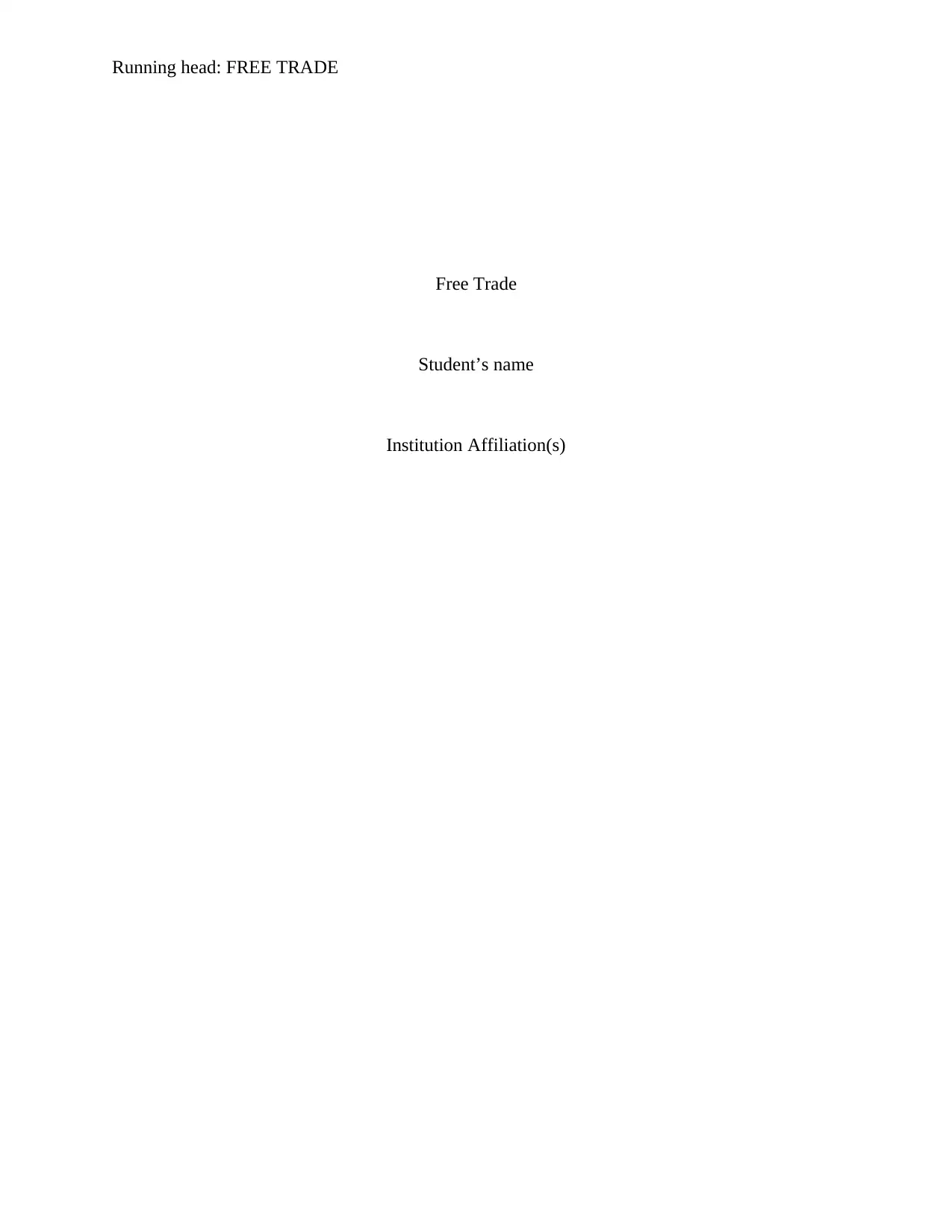
Running head: FREE TRADE
Free Trade
Student’s name
Institution Affiliation(s)
Free Trade
Student’s name
Institution Affiliation(s)
Paraphrase This Document
Need a fresh take? Get an instant paraphrase of this document with our AI Paraphraser
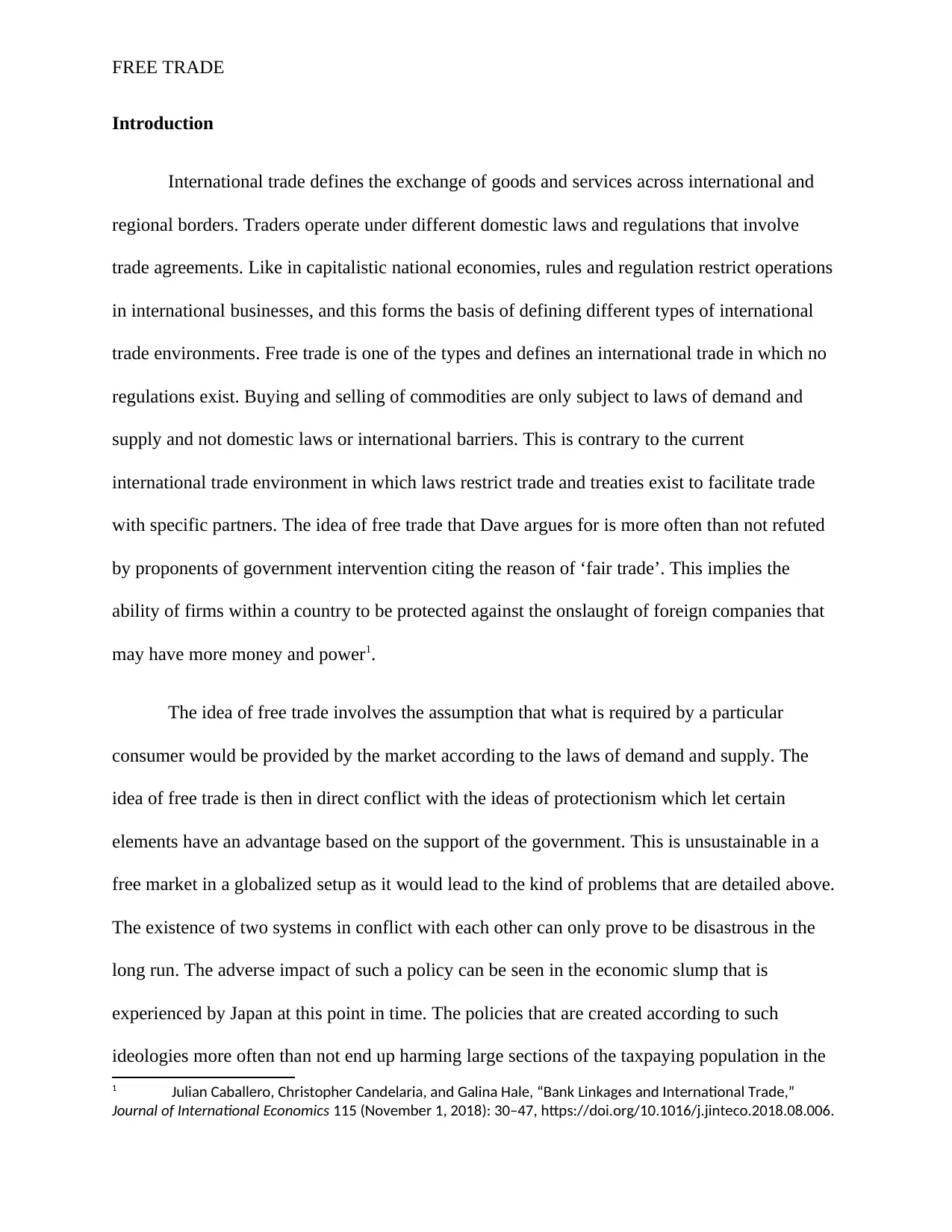
FREE TRADE
Introduction
International trade defines the exchange of goods and services across international and
regional borders. Traders operate under different domestic laws and regulations that involve
trade agreements. Like in capitalistic national economies, rules and regulation restrict operations
in international businesses, and this forms the basis of defining different types of international
trade environments. Free trade is one of the types and defines an international trade in which no
regulations exist. Buying and selling of commodities are only subject to laws of demand and
supply and not domestic laws or international barriers. This is contrary to the current
international trade environment in which laws restrict trade and treaties exist to facilitate trade
with specific partners. The idea of free trade that Dave argues for is more often than not refuted
by proponents of government intervention citing the reason of ‘fair trade’. This implies the
ability of firms within a country to be protected against the onslaught of foreign companies that
may have more money and power1.
The idea of free trade involves the assumption that what is required by a particular
consumer would be provided by the market according to the laws of demand and supply. The
idea of free trade is then in direct conflict with the ideas of protectionism which let certain
elements have an advantage based on the support of the government. This is unsustainable in a
free market in a globalized setup as it would lead to the kind of problems that are detailed above.
The existence of two systems in conflict with each other can only prove to be disastrous in the
long run. The adverse impact of such a policy can be seen in the economic slump that is
experienced by Japan at this point in time. The policies that are created according to such
ideologies more often than not end up harming large sections of the taxpaying population in the
1 Julian Caballero, Christopher Candelaria, and Galina Hale, “Bank Linkages and International Trade,”
Journal of International Economics 115 (November 1, 2018): 30–47, https://doi.org/10.1016/j.jinteco.2018.08.006.
Introduction
International trade defines the exchange of goods and services across international and
regional borders. Traders operate under different domestic laws and regulations that involve
trade agreements. Like in capitalistic national economies, rules and regulation restrict operations
in international businesses, and this forms the basis of defining different types of international
trade environments. Free trade is one of the types and defines an international trade in which no
regulations exist. Buying and selling of commodities are only subject to laws of demand and
supply and not domestic laws or international barriers. This is contrary to the current
international trade environment in which laws restrict trade and treaties exist to facilitate trade
with specific partners. The idea of free trade that Dave argues for is more often than not refuted
by proponents of government intervention citing the reason of ‘fair trade’. This implies the
ability of firms within a country to be protected against the onslaught of foreign companies that
may have more money and power1.
The idea of free trade involves the assumption that what is required by a particular
consumer would be provided by the market according to the laws of demand and supply. The
idea of free trade is then in direct conflict with the ideas of protectionism which let certain
elements have an advantage based on the support of the government. This is unsustainable in a
free market in a globalized setup as it would lead to the kind of problems that are detailed above.
The existence of two systems in conflict with each other can only prove to be disastrous in the
long run. The adverse impact of such a policy can be seen in the economic slump that is
experienced by Japan at this point in time. The policies that are created according to such
ideologies more often than not end up harming large sections of the taxpaying population in the
1 Julian Caballero, Christopher Candelaria, and Galina Hale, “Bank Linkages and International Trade,”
Journal of International Economics 115 (November 1, 2018): 30–47, https://doi.org/10.1016/j.jinteco.2018.08.006.
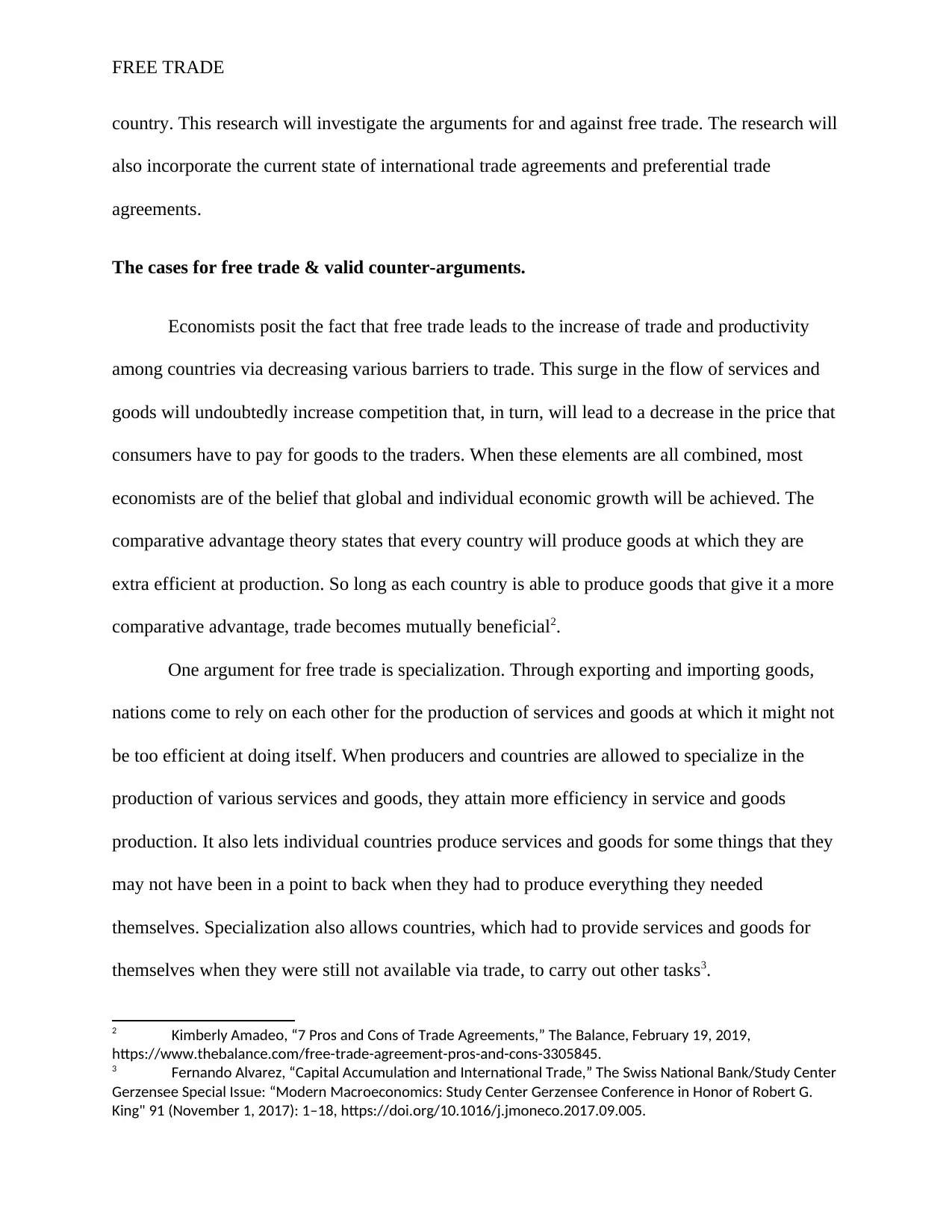
FREE TRADE
country. This research will investigate the arguments for and against free trade. The research will
also incorporate the current state of international trade agreements and preferential trade
agreements.
The cases for free trade & valid counter-arguments.
Economists posit the fact that free trade leads to the increase of trade and productivity
among countries via decreasing various barriers to trade. This surge in the flow of services and
goods will undoubtedly increase competition that, in turn, will lead to a decrease in the price that
consumers have to pay for goods to the traders. When these elements are all combined, most
economists are of the belief that global and individual economic growth will be achieved. The
comparative advantage theory states that every country will produce goods at which they are
extra efficient at production. So long as each country is able to produce goods that give it a more
comparative advantage, trade becomes mutually beneficial2.
One argument for free trade is specialization. Through exporting and importing goods,
nations come to rely on each other for the production of services and goods at which it might not
be too efficient at doing itself. When producers and countries are allowed to specialize in the
production of various services and goods, they attain more efficiency in service and goods
production. It also lets individual countries produce services and goods for some things that they
may not have been in a point to back when they had to produce everything they needed
themselves. Specialization also allows countries, which had to provide services and goods for
themselves when they were still not available via trade, to carry out other tasks3.
2 Kimberly Amadeo, “7 Pros and Cons of Trade Agreements,” The Balance, February 19, 2019,
https://www.thebalance.com/free-trade-agreement-pros-and-cons-3305845.
3 Fernando Alvarez, “Capital Accumulation and International Trade,” The Swiss National Bank/Study Center
Gerzensee Special Issue: “Modern Macroeconomics: Study Center Gerzensee Conference in Honor of Robert G.
King" 91 (November 1, 2017): 1–18, https://doi.org/10.1016/j.jmoneco.2017.09.005.
country. This research will investigate the arguments for and against free trade. The research will
also incorporate the current state of international trade agreements and preferential trade
agreements.
The cases for free trade & valid counter-arguments.
Economists posit the fact that free trade leads to the increase of trade and productivity
among countries via decreasing various barriers to trade. This surge in the flow of services and
goods will undoubtedly increase competition that, in turn, will lead to a decrease in the price that
consumers have to pay for goods to the traders. When these elements are all combined, most
economists are of the belief that global and individual economic growth will be achieved. The
comparative advantage theory states that every country will produce goods at which they are
extra efficient at production. So long as each country is able to produce goods that give it a more
comparative advantage, trade becomes mutually beneficial2.
One argument for free trade is specialization. Through exporting and importing goods,
nations come to rely on each other for the production of services and goods at which it might not
be too efficient at doing itself. When producers and countries are allowed to specialize in the
production of various services and goods, they attain more efficiency in service and goods
production. It also lets individual countries produce services and goods for some things that they
may not have been in a point to back when they had to produce everything they needed
themselves. Specialization also allows countries, which had to provide services and goods for
themselves when they were still not available via trade, to carry out other tasks3.
2 Kimberly Amadeo, “7 Pros and Cons of Trade Agreements,” The Balance, February 19, 2019,
https://www.thebalance.com/free-trade-agreement-pros-and-cons-3305845.
3 Fernando Alvarez, “Capital Accumulation and International Trade,” The Swiss National Bank/Study Center
Gerzensee Special Issue: “Modern Macroeconomics: Study Center Gerzensee Conference in Honor of Robert G.
King" 91 (November 1, 2017): 1–18, https://doi.org/10.1016/j.jmoneco.2017.09.005.
⊘ This is a preview!⊘
Do you want full access?
Subscribe today to unlock all pages.

Trusted by 1+ million students worldwide
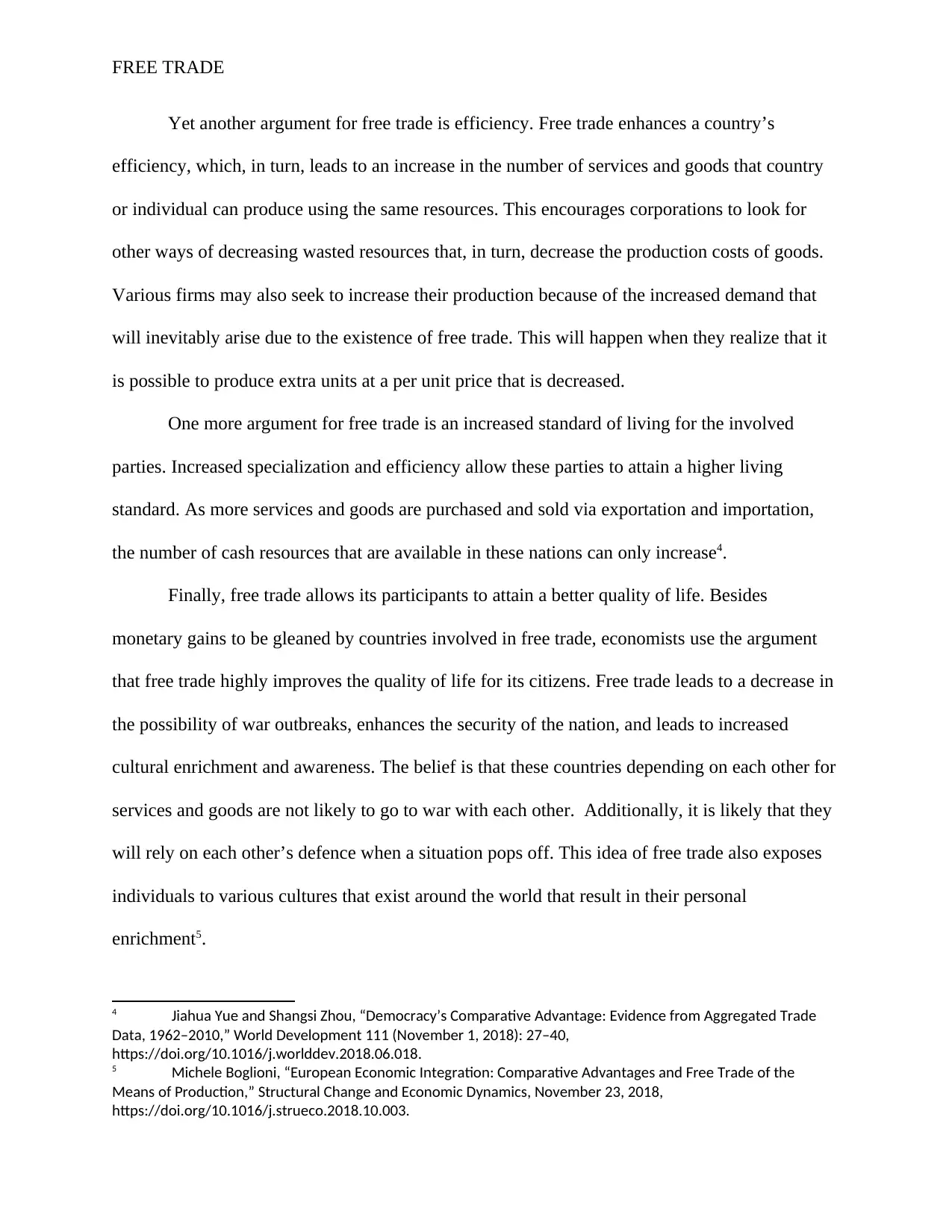
FREE TRADE
Yet another argument for free trade is efficiency. Free trade enhances a country’s
efficiency, which, in turn, leads to an increase in the number of services and goods that country
or individual can produce using the same resources. This encourages corporations to look for
other ways of decreasing wasted resources that, in turn, decrease the production costs of goods.
Various firms may also seek to increase their production because of the increased demand that
will inevitably arise due to the existence of free trade. This will happen when they realize that it
is possible to produce extra units at a per unit price that is decreased.
One more argument for free trade is an increased standard of living for the involved
parties. Increased specialization and efficiency allow these parties to attain a higher living
standard. As more services and goods are purchased and sold via exportation and importation,
the number of cash resources that are available in these nations can only increase4.
Finally, free trade allows its participants to attain a better quality of life. Besides
monetary gains to be gleaned by countries involved in free trade, economists use the argument
that free trade highly improves the quality of life for its citizens. Free trade leads to a decrease in
the possibility of war outbreaks, enhances the security of the nation, and leads to increased
cultural enrichment and awareness. The belief is that these countries depending on each other for
services and goods are not likely to go to war with each other. Additionally, it is likely that they
will rely on each other’s defence when a situation pops off. This idea of free trade also exposes
individuals to various cultures that exist around the world that result in their personal
enrichment5.
4 Jiahua Yue and Shangsi Zhou, “Democracy’s Comparative Advantage: Evidence from Aggregated Trade
Data, 1962–2010,” World Development 111 (November 1, 2018): 27–40,
https://doi.org/10.1016/j.worlddev.2018.06.018.
5 Michele Boglioni, “European Economic Integration: Comparative Advantages and Free Trade of the
Means of Production,” Structural Change and Economic Dynamics, November 23, 2018,
https://doi.org/10.1016/j.strueco.2018.10.003.
Yet another argument for free trade is efficiency. Free trade enhances a country’s
efficiency, which, in turn, leads to an increase in the number of services and goods that country
or individual can produce using the same resources. This encourages corporations to look for
other ways of decreasing wasted resources that, in turn, decrease the production costs of goods.
Various firms may also seek to increase their production because of the increased demand that
will inevitably arise due to the existence of free trade. This will happen when they realize that it
is possible to produce extra units at a per unit price that is decreased.
One more argument for free trade is an increased standard of living for the involved
parties. Increased specialization and efficiency allow these parties to attain a higher living
standard. As more services and goods are purchased and sold via exportation and importation,
the number of cash resources that are available in these nations can only increase4.
Finally, free trade allows its participants to attain a better quality of life. Besides
monetary gains to be gleaned by countries involved in free trade, economists use the argument
that free trade highly improves the quality of life for its citizens. Free trade leads to a decrease in
the possibility of war outbreaks, enhances the security of the nation, and leads to increased
cultural enrichment and awareness. The belief is that these countries depending on each other for
services and goods are not likely to go to war with each other. Additionally, it is likely that they
will rely on each other’s defence when a situation pops off. This idea of free trade also exposes
individuals to various cultures that exist around the world that result in their personal
enrichment5.
4 Jiahua Yue and Shangsi Zhou, “Democracy’s Comparative Advantage: Evidence from Aggregated Trade
Data, 1962–2010,” World Development 111 (November 1, 2018): 27–40,
https://doi.org/10.1016/j.worlddev.2018.06.018.
5 Michele Boglioni, “European Economic Integration: Comparative Advantages and Free Trade of the
Means of Production,” Structural Change and Economic Dynamics, November 23, 2018,
https://doi.org/10.1016/j.strueco.2018.10.003.
Paraphrase This Document
Need a fresh take? Get an instant paraphrase of this document with our AI Paraphraser
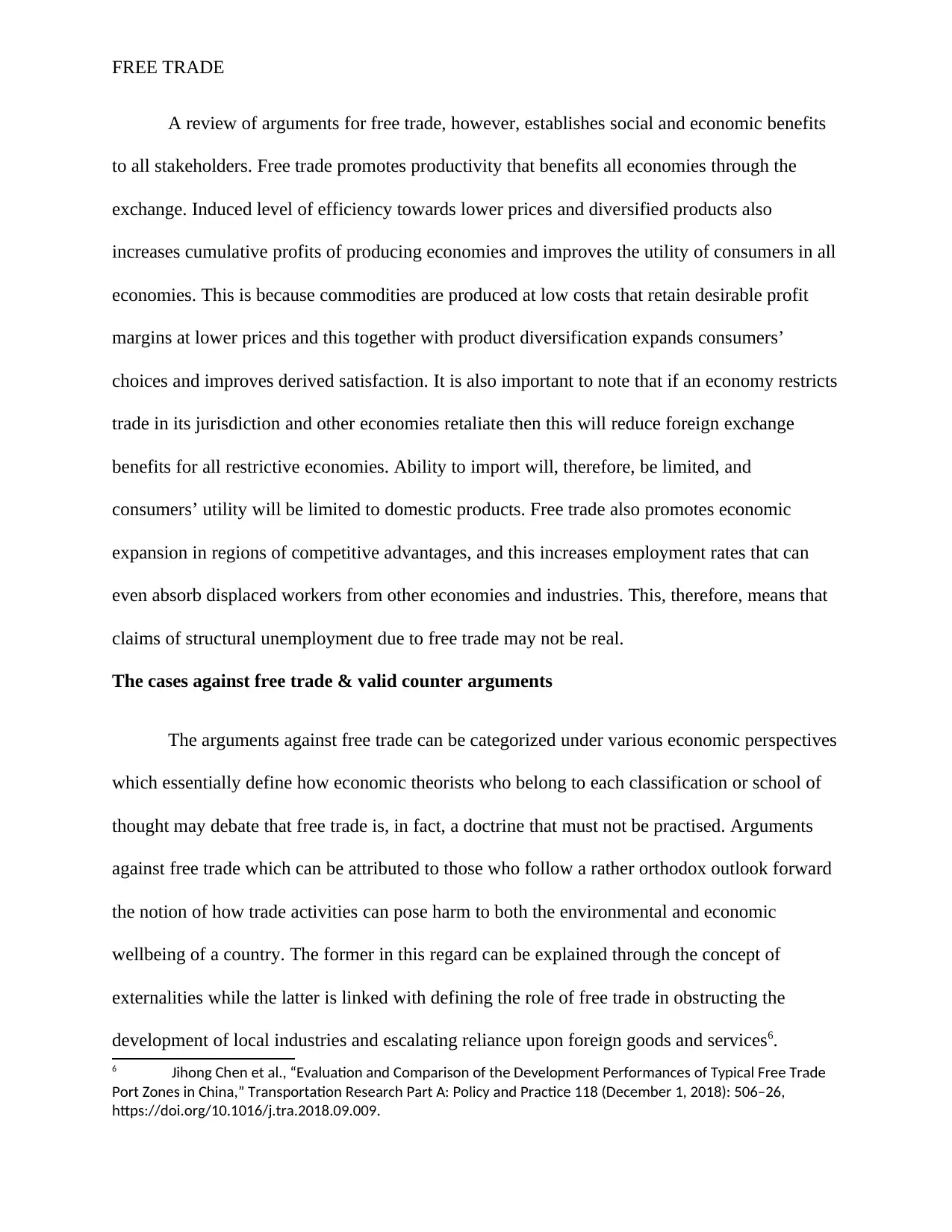
FREE TRADE
A review of arguments for free trade, however, establishes social and economic benefits
to all stakeholders. Free trade promotes productivity that benefits all economies through the
exchange. Induced level of efficiency towards lower prices and diversified products also
increases cumulative profits of producing economies and improves the utility of consumers in all
economies. This is because commodities are produced at low costs that retain desirable profit
margins at lower prices and this together with product diversification expands consumers’
choices and improves derived satisfaction. It is also important to note that if an economy restricts
trade in its jurisdiction and other economies retaliate then this will reduce foreign exchange
benefits for all restrictive economies. Ability to import will, therefore, be limited, and
consumers’ utility will be limited to domestic products. Free trade also promotes economic
expansion in regions of competitive advantages, and this increases employment rates that can
even absorb displaced workers from other economies and industries. This, therefore, means that
claims of structural unemployment due to free trade may not be real.
The cases against free trade & valid counter arguments
The arguments against free trade can be categorized under various economic perspectives
which essentially define how economic theorists who belong to each classification or school of
thought may debate that free trade is, in fact, a doctrine that must not be practised. Arguments
against free trade which can be attributed to those who follow a rather orthodox outlook forward
the notion of how trade activities can pose harm to both the environmental and economic
wellbeing of a country. The former in this regard can be explained through the concept of
externalities while the latter is linked with defining the role of free trade in obstructing the
development of local industries and escalating reliance upon foreign goods and services6.
6 Jihong Chen et al., “Evaluation and Comparison of the Development Performances of Typical Free Trade
Port Zones in China,” Transportation Research Part A: Policy and Practice 118 (December 1, 2018): 506–26,
https://doi.org/10.1016/j.tra.2018.09.009.
A review of arguments for free trade, however, establishes social and economic benefits
to all stakeholders. Free trade promotes productivity that benefits all economies through the
exchange. Induced level of efficiency towards lower prices and diversified products also
increases cumulative profits of producing economies and improves the utility of consumers in all
economies. This is because commodities are produced at low costs that retain desirable profit
margins at lower prices and this together with product diversification expands consumers’
choices and improves derived satisfaction. It is also important to note that if an economy restricts
trade in its jurisdiction and other economies retaliate then this will reduce foreign exchange
benefits for all restrictive economies. Ability to import will, therefore, be limited, and
consumers’ utility will be limited to domestic products. Free trade also promotes economic
expansion in regions of competitive advantages, and this increases employment rates that can
even absorb displaced workers from other economies and industries. This, therefore, means that
claims of structural unemployment due to free trade may not be real.
The cases against free trade & valid counter arguments
The arguments against free trade can be categorized under various economic perspectives
which essentially define how economic theorists who belong to each classification or school of
thought may debate that free trade is, in fact, a doctrine that must not be practised. Arguments
against free trade which can be attributed to those who follow a rather orthodox outlook forward
the notion of how trade activities can pose harm to both the environmental and economic
wellbeing of a country. The former in this regard can be explained through the concept of
externalities while the latter is linked with defining the role of free trade in obstructing the
development of local industries and escalating reliance upon foreign goods and services6.
6 Jihong Chen et al., “Evaluation and Comparison of the Development Performances of Typical Free Trade
Port Zones in China,” Transportation Research Part A: Policy and Practice 118 (December 1, 2018): 506–26,
https://doi.org/10.1016/j.tra.2018.09.009.
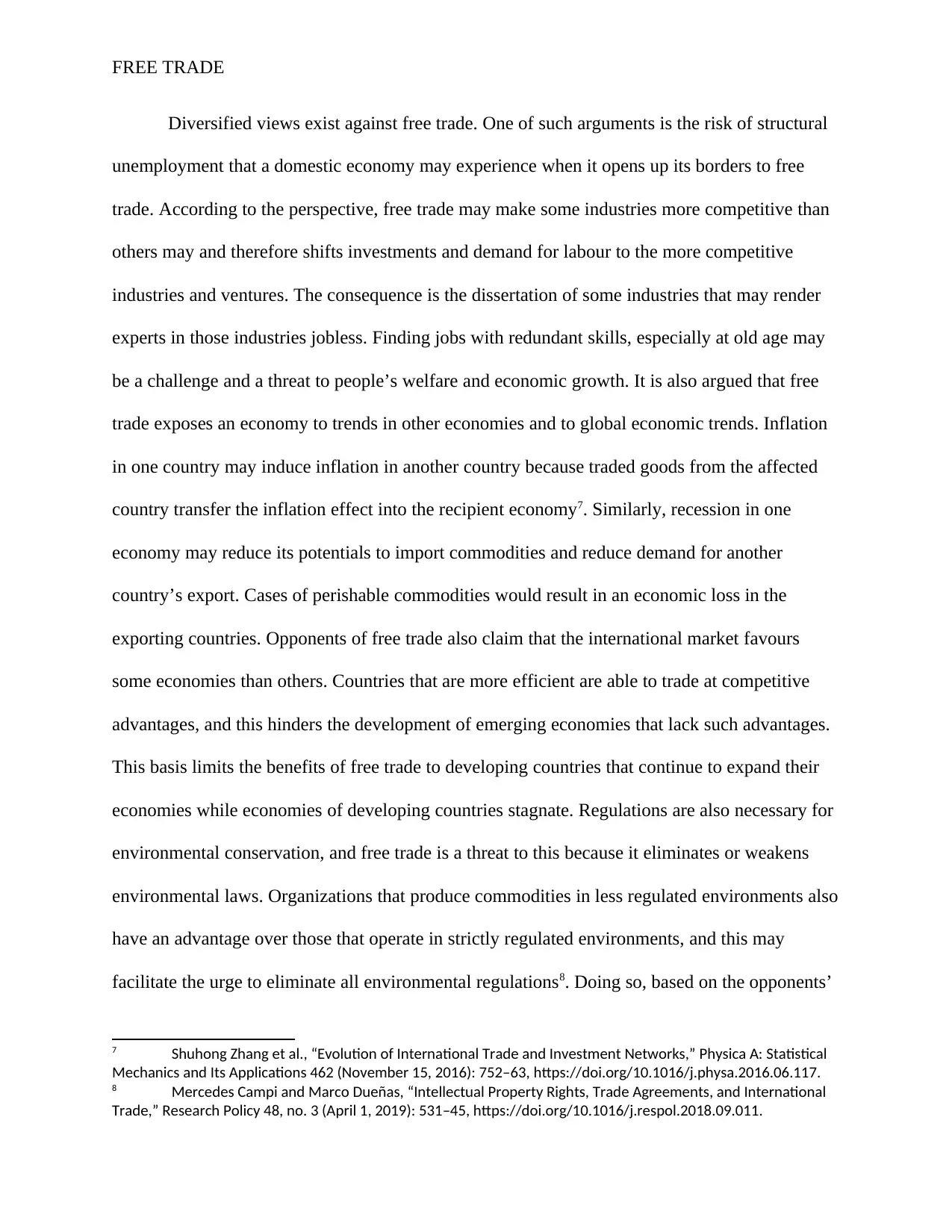
FREE TRADE
Diversified views exist against free trade. One of such arguments is the risk of structural
unemployment that a domestic economy may experience when it opens up its borders to free
trade. According to the perspective, free trade may make some industries more competitive than
others may and therefore shifts investments and demand for labour to the more competitive
industries and ventures. The consequence is the dissertation of some industries that may render
experts in those industries jobless. Finding jobs with redundant skills, especially at old age may
be a challenge and a threat to people’s welfare and economic growth. It is also argued that free
trade exposes an economy to trends in other economies and to global economic trends. Inflation
in one country may induce inflation in another country because traded goods from the affected
country transfer the inflation effect into the recipient economy7. Similarly, recession in one
economy may reduce its potentials to import commodities and reduce demand for another
country’s export. Cases of perishable commodities would result in an economic loss in the
exporting countries. Opponents of free trade also claim that the international market favours
some economies than others. Countries that are more efficient are able to trade at competitive
advantages, and this hinders the development of emerging economies that lack such advantages.
This basis limits the benefits of free trade to developing countries that continue to expand their
economies while economies of developing countries stagnate. Regulations are also necessary for
environmental conservation, and free trade is a threat to this because it eliminates or weakens
environmental laws. Organizations that produce commodities in less regulated environments also
have an advantage over those that operate in strictly regulated environments, and this may
facilitate the urge to eliminate all environmental regulations8. Doing so, based on the opponents’
7 Shuhong Zhang et al., “Evolution of International Trade and Investment Networks,” Physica A: Statistical
Mechanics and Its Applications 462 (November 15, 2016): 752–63, https://doi.org/10.1016/j.physa.2016.06.117.
8 Mercedes Campi and Marco Dueñas, “Intellectual Property Rights, Trade Agreements, and International
Trade,” Research Policy 48, no. 3 (April 1, 2019): 531–45, https://doi.org/10.1016/j.respol.2018.09.011.
Diversified views exist against free trade. One of such arguments is the risk of structural
unemployment that a domestic economy may experience when it opens up its borders to free
trade. According to the perspective, free trade may make some industries more competitive than
others may and therefore shifts investments and demand for labour to the more competitive
industries and ventures. The consequence is the dissertation of some industries that may render
experts in those industries jobless. Finding jobs with redundant skills, especially at old age may
be a challenge and a threat to people’s welfare and economic growth. It is also argued that free
trade exposes an economy to trends in other economies and to global economic trends. Inflation
in one country may induce inflation in another country because traded goods from the affected
country transfer the inflation effect into the recipient economy7. Similarly, recession in one
economy may reduce its potentials to import commodities and reduce demand for another
country’s export. Cases of perishable commodities would result in an economic loss in the
exporting countries. Opponents of free trade also claim that the international market favours
some economies than others. Countries that are more efficient are able to trade at competitive
advantages, and this hinders the development of emerging economies that lack such advantages.
This basis limits the benefits of free trade to developing countries that continue to expand their
economies while economies of developing countries stagnate. Regulations are also necessary for
environmental conservation, and free trade is a threat to this because it eliminates or weakens
environmental laws. Organizations that produce commodities in less regulated environments also
have an advantage over those that operate in strictly regulated environments, and this may
facilitate the urge to eliminate all environmental regulations8. Doing so, based on the opponents’
7 Shuhong Zhang et al., “Evolution of International Trade and Investment Networks,” Physica A: Statistical
Mechanics and Its Applications 462 (November 15, 2016): 752–63, https://doi.org/10.1016/j.physa.2016.06.117.
8 Mercedes Campi and Marco Dueñas, “Intellectual Property Rights, Trade Agreements, and International
Trade,” Research Policy 48, no. 3 (April 1, 2019): 531–45, https://doi.org/10.1016/j.respol.2018.09.011.
⊘ This is a preview!⊘
Do you want full access?
Subscribe today to unlock all pages.

Trusted by 1+ million students worldwide
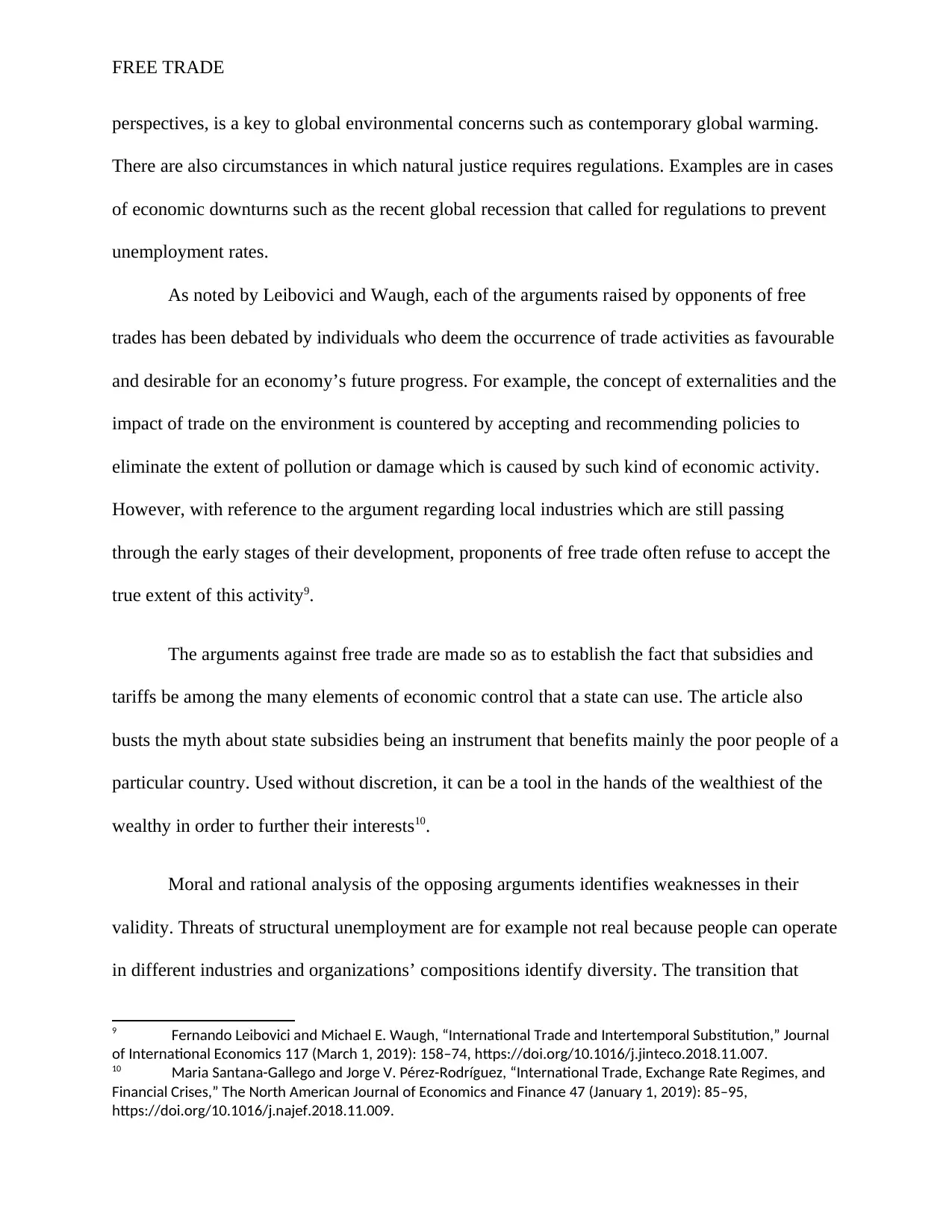
FREE TRADE
perspectives, is a key to global environmental concerns such as contemporary global warming.
There are also circumstances in which natural justice requires regulations. Examples are in cases
of economic downturns such as the recent global recession that called for regulations to prevent
unemployment rates.
As noted by Leibovici and Waugh, each of the arguments raised by opponents of free
trades has been debated by individuals who deem the occurrence of trade activities as favourable
and desirable for an economy’s future progress. For example, the concept of externalities and the
impact of trade on the environment is countered by accepting and recommending policies to
eliminate the extent of pollution or damage which is caused by such kind of economic activity.
However, with reference to the argument regarding local industries which are still passing
through the early stages of their development, proponents of free trade often refuse to accept the
true extent of this activity9.
The arguments against free trade are made so as to establish the fact that subsidies and
tariffs be among the many elements of economic control that a state can use. The article also
busts the myth about state subsidies being an instrument that benefits mainly the poor people of a
particular country. Used without discretion, it can be a tool in the hands of the wealthiest of the
wealthy in order to further their interests10.
Moral and rational analysis of the opposing arguments identifies weaknesses in their
validity. Threats of structural unemployment are for example not real because people can operate
in different industries and organizations’ compositions identify diversity. The transition that
9 Fernando Leibovici and Michael E. Waugh, “International Trade and Intertemporal Substitution,” Journal
of International Economics 117 (March 1, 2019): 158–74, https://doi.org/10.1016/j.jinteco.2018.11.007.
10 Maria Santana-Gallego and Jorge V. Pérez-Rodríguez, “International Trade, Exchange Rate Regimes, and
Financial Crises,” The North American Journal of Economics and Finance 47 (January 1, 2019): 85–95,
https://doi.org/10.1016/j.najef.2018.11.009.
perspectives, is a key to global environmental concerns such as contemporary global warming.
There are also circumstances in which natural justice requires regulations. Examples are in cases
of economic downturns such as the recent global recession that called for regulations to prevent
unemployment rates.
As noted by Leibovici and Waugh, each of the arguments raised by opponents of free
trades has been debated by individuals who deem the occurrence of trade activities as favourable
and desirable for an economy’s future progress. For example, the concept of externalities and the
impact of trade on the environment is countered by accepting and recommending policies to
eliminate the extent of pollution or damage which is caused by such kind of economic activity.
However, with reference to the argument regarding local industries which are still passing
through the early stages of their development, proponents of free trade often refuse to accept the
true extent of this activity9.
The arguments against free trade are made so as to establish the fact that subsidies and
tariffs be among the many elements of economic control that a state can use. The article also
busts the myth about state subsidies being an instrument that benefits mainly the poor people of a
particular country. Used without discretion, it can be a tool in the hands of the wealthiest of the
wealthy in order to further their interests10.
Moral and rational analysis of the opposing arguments identifies weaknesses in their
validity. Threats of structural unemployment are for example not real because people can operate
in different industries and organizations’ compositions identify diversity. The transition that
9 Fernando Leibovici and Michael E. Waugh, “International Trade and Intertemporal Substitution,” Journal
of International Economics 117 (March 1, 2019): 158–74, https://doi.org/10.1016/j.jinteco.2018.11.007.
10 Maria Santana-Gallego and Jorge V. Pérez-Rodríguez, “International Trade, Exchange Rate Regimes, and
Financial Crises,” The North American Journal of Economics and Finance 47 (January 1, 2019): 85–95,
https://doi.org/10.1016/j.najef.2018.11.009.
Paraphrase This Document
Need a fresh take? Get an instant paraphrase of this document with our AI Paraphraser
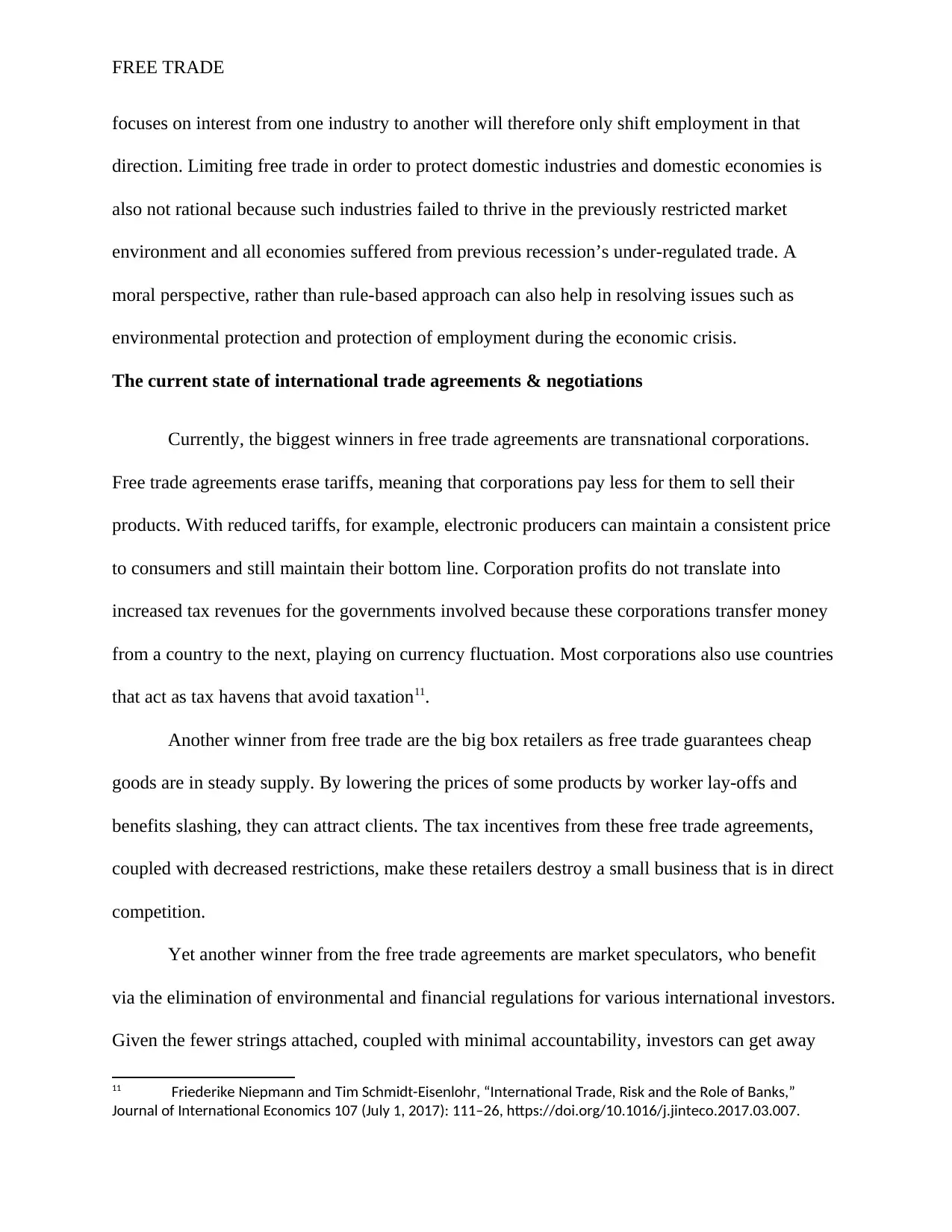
FREE TRADE
focuses on interest from one industry to another will therefore only shift employment in that
direction. Limiting free trade in order to protect domestic industries and domestic economies is
also not rational because such industries failed to thrive in the previously restricted market
environment and all economies suffered from previous recession’s under-regulated trade. A
moral perspective, rather than rule-based approach can also help in resolving issues such as
environmental protection and protection of employment during the economic crisis.
The current state of international trade agreements & negotiations
Currently, the biggest winners in free trade agreements are transnational corporations.
Free trade agreements erase tariffs, meaning that corporations pay less for them to sell their
products. With reduced tariffs, for example, electronic producers can maintain a consistent price
to consumers and still maintain their bottom line. Corporation profits do not translate into
increased tax revenues for the governments involved because these corporations transfer money
from a country to the next, playing on currency fluctuation. Most corporations also use countries
that act as tax havens that avoid taxation11.
Another winner from free trade are the big box retailers as free trade guarantees cheap
goods are in steady supply. By lowering the prices of some products by worker lay-offs and
benefits slashing, they can attract clients. The tax incentives from these free trade agreements,
coupled with decreased restrictions, make these retailers destroy a small business that is in direct
competition.
Yet another winner from the free trade agreements are market speculators, who benefit
via the elimination of environmental and financial regulations for various international investors.
Given the fewer strings attached, coupled with minimal accountability, investors can get away
11 Friederike Niepmann and Tim Schmidt-Eisenlohr, “International Trade, Risk and the Role of Banks,”
Journal of International Economics 107 (July 1, 2017): 111–26, https://doi.org/10.1016/j.jinteco.2017.03.007.
focuses on interest from one industry to another will therefore only shift employment in that
direction. Limiting free trade in order to protect domestic industries and domestic economies is
also not rational because such industries failed to thrive in the previously restricted market
environment and all economies suffered from previous recession’s under-regulated trade. A
moral perspective, rather than rule-based approach can also help in resolving issues such as
environmental protection and protection of employment during the economic crisis.
The current state of international trade agreements & negotiations
Currently, the biggest winners in free trade agreements are transnational corporations.
Free trade agreements erase tariffs, meaning that corporations pay less for them to sell their
products. With reduced tariffs, for example, electronic producers can maintain a consistent price
to consumers and still maintain their bottom line. Corporation profits do not translate into
increased tax revenues for the governments involved because these corporations transfer money
from a country to the next, playing on currency fluctuation. Most corporations also use countries
that act as tax havens that avoid taxation11.
Another winner from free trade are the big box retailers as free trade guarantees cheap
goods are in steady supply. By lowering the prices of some products by worker lay-offs and
benefits slashing, they can attract clients. The tax incentives from these free trade agreements,
coupled with decreased restrictions, make these retailers destroy a small business that is in direct
competition.
Yet another winner from the free trade agreements are market speculators, who benefit
via the elimination of environmental and financial regulations for various international investors.
Given the fewer strings attached, coupled with minimal accountability, investors can get away
11 Friederike Niepmann and Tim Schmidt-Eisenlohr, “International Trade, Risk and the Role of Banks,”
Journal of International Economics 107 (July 1, 2017): 111–26, https://doi.org/10.1016/j.jinteco.2017.03.007.
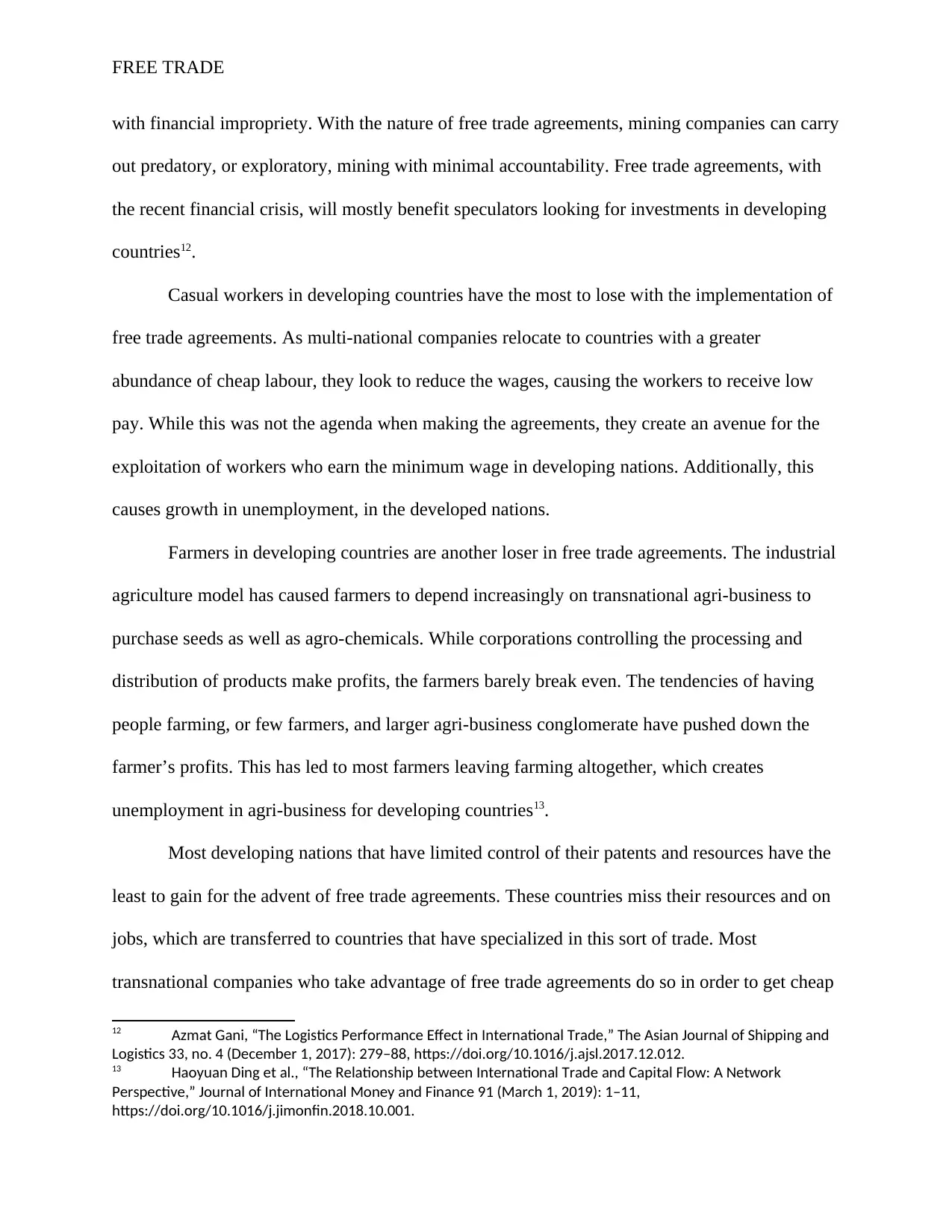
FREE TRADE
with financial impropriety. With the nature of free trade agreements, mining companies can carry
out predatory, or exploratory, mining with minimal accountability. Free trade agreements, with
the recent financial crisis, will mostly benefit speculators looking for investments in developing
countries12.
Casual workers in developing countries have the most to lose with the implementation of
free trade agreements. As multi-national companies relocate to countries with a greater
abundance of cheap labour, they look to reduce the wages, causing the workers to receive low
pay. While this was not the agenda when making the agreements, they create an avenue for the
exploitation of workers who earn the minimum wage in developing nations. Additionally, this
causes growth in unemployment, in the developed nations.
Farmers in developing countries are another loser in free trade agreements. The industrial
agriculture model has caused farmers to depend increasingly on transnational agri-business to
purchase seeds as well as agro-chemicals. While corporations controlling the processing and
distribution of products make profits, the farmers barely break even. The tendencies of having
people farming, or few farmers, and larger agri-business conglomerate have pushed down the
farmer’s profits. This has led to most farmers leaving farming altogether, which creates
unemployment in agri-business for developing countries13.
Most developing nations that have limited control of their patents and resources have the
least to gain for the advent of free trade agreements. These countries miss their resources and on
jobs, which are transferred to countries that have specialized in this sort of trade. Most
transnational companies who take advantage of free trade agreements do so in order to get cheap
12 Azmat Gani, “The Logistics Performance Effect in International Trade,” The Asian Journal of Shipping and
Logistics 33, no. 4 (December 1, 2017): 279–88, https://doi.org/10.1016/j.ajsl.2017.12.012.
13 Haoyuan Ding et al., “The Relationship between International Trade and Capital Flow: A Network
Perspective,” Journal of International Money and Finance 91 (March 1, 2019): 1–11,
https://doi.org/10.1016/j.jimonfin.2018.10.001.
with financial impropriety. With the nature of free trade agreements, mining companies can carry
out predatory, or exploratory, mining with minimal accountability. Free trade agreements, with
the recent financial crisis, will mostly benefit speculators looking for investments in developing
countries12.
Casual workers in developing countries have the most to lose with the implementation of
free trade agreements. As multi-national companies relocate to countries with a greater
abundance of cheap labour, they look to reduce the wages, causing the workers to receive low
pay. While this was not the agenda when making the agreements, they create an avenue for the
exploitation of workers who earn the minimum wage in developing nations. Additionally, this
causes growth in unemployment, in the developed nations.
Farmers in developing countries are another loser in free trade agreements. The industrial
agriculture model has caused farmers to depend increasingly on transnational agri-business to
purchase seeds as well as agro-chemicals. While corporations controlling the processing and
distribution of products make profits, the farmers barely break even. The tendencies of having
people farming, or few farmers, and larger agri-business conglomerate have pushed down the
farmer’s profits. This has led to most farmers leaving farming altogether, which creates
unemployment in agri-business for developing countries13.
Most developing nations that have limited control of their patents and resources have the
least to gain for the advent of free trade agreements. These countries miss their resources and on
jobs, which are transferred to countries that have specialized in this sort of trade. Most
transnational companies who take advantage of free trade agreements do so in order to get cheap
12 Azmat Gani, “The Logistics Performance Effect in International Trade,” The Asian Journal of Shipping and
Logistics 33, no. 4 (December 1, 2017): 279–88, https://doi.org/10.1016/j.ajsl.2017.12.012.
13 Haoyuan Ding et al., “The Relationship between International Trade and Capital Flow: A Network
Perspective,” Journal of International Money and Finance 91 (March 1, 2019): 1–11,
https://doi.org/10.1016/j.jimonfin.2018.10.001.
⊘ This is a preview!⊘
Do you want full access?
Subscribe today to unlock all pages.

Trusted by 1+ million students worldwide
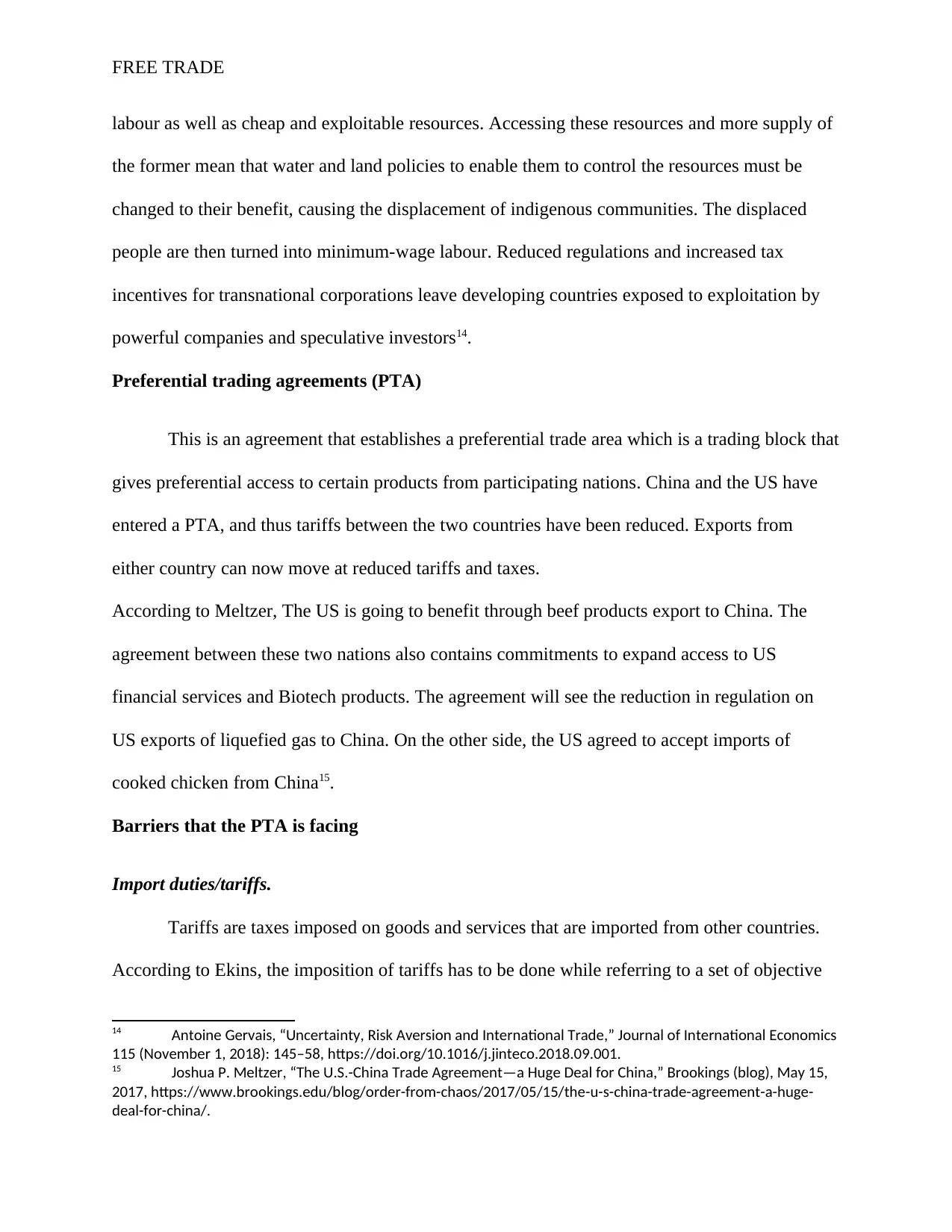
FREE TRADE
labour as well as cheap and exploitable resources. Accessing these resources and more supply of
the former mean that water and land policies to enable them to control the resources must be
changed to their benefit, causing the displacement of indigenous communities. The displaced
people are then turned into minimum-wage labour. Reduced regulations and increased tax
incentives for transnational corporations leave developing countries exposed to exploitation by
powerful companies and speculative investors14.
Preferential trading agreements (PTA)
This is an agreement that establishes a preferential trade area which is a trading block that
gives preferential access to certain products from participating nations. China and the US have
entered a PTA, and thus tariffs between the two countries have been reduced. Exports from
either country can now move at reduced tariffs and taxes.
According to Meltzer, The US is going to benefit through beef products export to China. The
agreement between these two nations also contains commitments to expand access to US
financial services and Biotech products. The agreement will see the reduction in regulation on
US exports of liquefied gas to China. On the other side, the US agreed to accept imports of
cooked chicken from China15.
Barriers that the PTA is facing
Import duties/tariffs.
Tariffs are taxes imposed on goods and services that are imported from other countries.
According to Ekins, the imposition of tariffs has to be done while referring to a set of objective
14 Antoine Gervais, “Uncertainty, Risk Aversion and International Trade,” Journal of International Economics
115 (November 1, 2018): 145–58, https://doi.org/10.1016/j.jinteco.2018.09.001.
15 Joshua P. Meltzer, “The U.S.-China Trade Agreement—a Huge Deal for China,” Brookings (blog), May 15,
2017, https://www.brookings.edu/blog/order-from-chaos/2017/05/15/the-u-s-china-trade-agreement-a-huge-
deal-for-china/.
labour as well as cheap and exploitable resources. Accessing these resources and more supply of
the former mean that water and land policies to enable them to control the resources must be
changed to their benefit, causing the displacement of indigenous communities. The displaced
people are then turned into minimum-wage labour. Reduced regulations and increased tax
incentives for transnational corporations leave developing countries exposed to exploitation by
powerful companies and speculative investors14.
Preferential trading agreements (PTA)
This is an agreement that establishes a preferential trade area which is a trading block that
gives preferential access to certain products from participating nations. China and the US have
entered a PTA, and thus tariffs between the two countries have been reduced. Exports from
either country can now move at reduced tariffs and taxes.
According to Meltzer, The US is going to benefit through beef products export to China. The
agreement between these two nations also contains commitments to expand access to US
financial services and Biotech products. The agreement will see the reduction in regulation on
US exports of liquefied gas to China. On the other side, the US agreed to accept imports of
cooked chicken from China15.
Barriers that the PTA is facing
Import duties/tariffs.
Tariffs are taxes imposed on goods and services that are imported from other countries.
According to Ekins, the imposition of tariffs has to be done while referring to a set of objective
14 Antoine Gervais, “Uncertainty, Risk Aversion and International Trade,” Journal of International Economics
115 (November 1, 2018): 145–58, https://doi.org/10.1016/j.jinteco.2018.09.001.
15 Joshua P. Meltzer, “The U.S.-China Trade Agreement—a Huge Deal for China,” Brookings (blog), May 15,
2017, https://www.brookings.edu/blog/order-from-chaos/2017/05/15/the-u-s-china-trade-agreement-a-huge-
deal-for-china/.
Paraphrase This Document
Need a fresh take? Get an instant paraphrase of this document with our AI Paraphraser
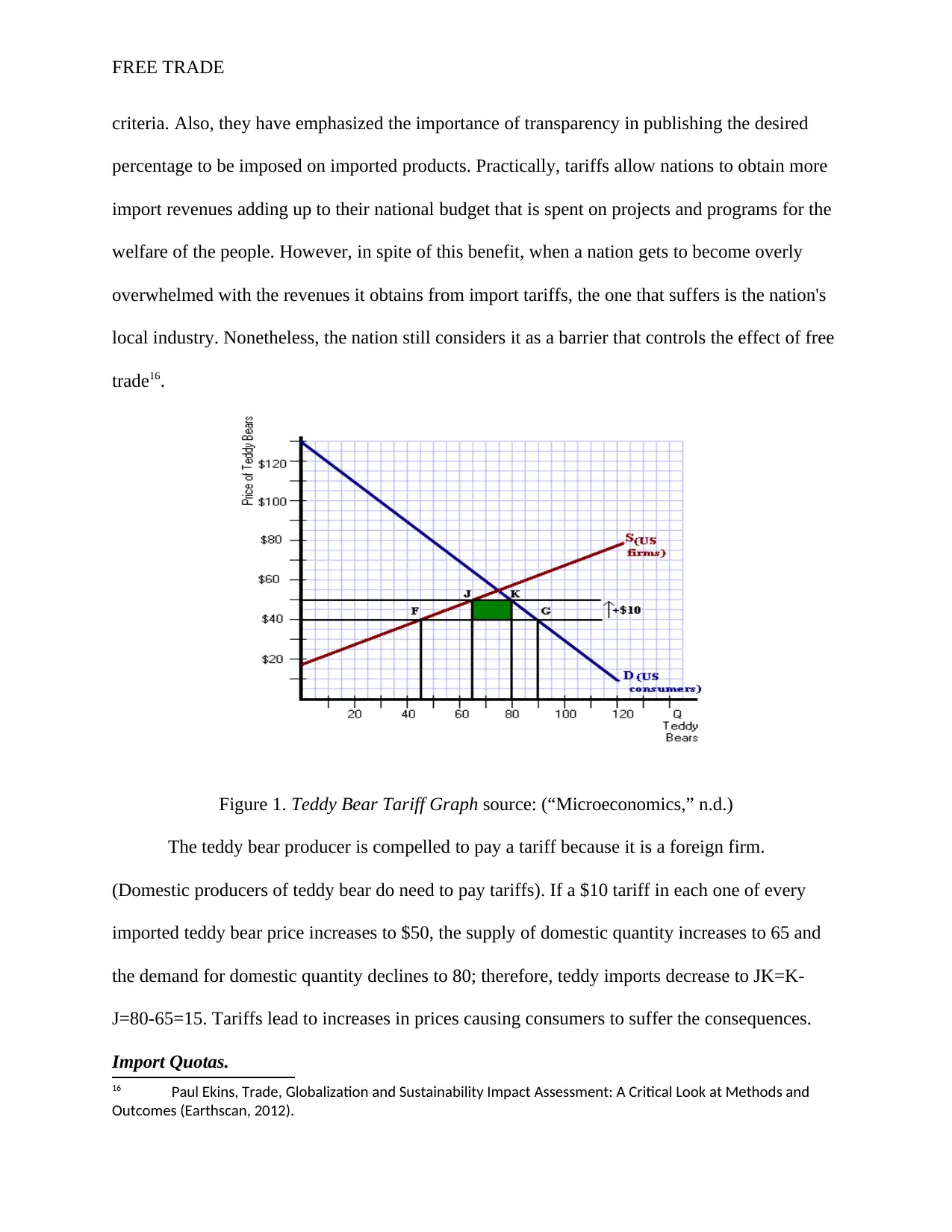
FREE TRADE
criteria. Also, they have emphasized the importance of transparency in publishing the desired
percentage to be imposed on imported products. Practically, tariffs allow nations to obtain more
import revenues adding up to their national budget that is spent on projects and programs for the
welfare of the people. However, in spite of this benefit, when a nation gets to become overly
overwhelmed with the revenues it obtains from import tariffs, the one that suffers is the nation's
local industry. Nonetheless, the nation still considers it as a barrier that controls the effect of free
trade16.
Figure 1. Teddy Bear Tariff Graph source: (“Microeconomics,” n.d.)
The teddy bear producer is compelled to pay a tariff because it is a foreign firm.
(Domestic producers of teddy bear do need to pay tariffs). If a $10 tariff in each one of every
imported teddy bear price increases to $50, the supply of domestic quantity increases to 65 and
the demand for domestic quantity declines to 80; therefore, teddy imports decrease to JK=K-
J=80-65=15. Tariffs lead to increases in prices causing consumers to suffer the consequences.
Import Quotas.
16 Paul Ekins, Trade, Globalization and Sustainability Impact Assessment: A Critical Look at Methods and
Outcomes (Earthscan, 2012).
criteria. Also, they have emphasized the importance of transparency in publishing the desired
percentage to be imposed on imported products. Practically, tariffs allow nations to obtain more
import revenues adding up to their national budget that is spent on projects and programs for the
welfare of the people. However, in spite of this benefit, when a nation gets to become overly
overwhelmed with the revenues it obtains from import tariffs, the one that suffers is the nation's
local industry. Nonetheless, the nation still considers it as a barrier that controls the effect of free
trade16.
Figure 1. Teddy Bear Tariff Graph source: (“Microeconomics,” n.d.)
The teddy bear producer is compelled to pay a tariff because it is a foreign firm.
(Domestic producers of teddy bear do need to pay tariffs). If a $10 tariff in each one of every
imported teddy bear price increases to $50, the supply of domestic quantity increases to 65 and
the demand for domestic quantity declines to 80; therefore, teddy imports decrease to JK=K-
J=80-65=15. Tariffs lead to increases in prices causing consumers to suffer the consequences.
Import Quotas.
16 Paul Ekins, Trade, Globalization and Sustainability Impact Assessment: A Critical Look at Methods and
Outcomes (Earthscan, 2012).
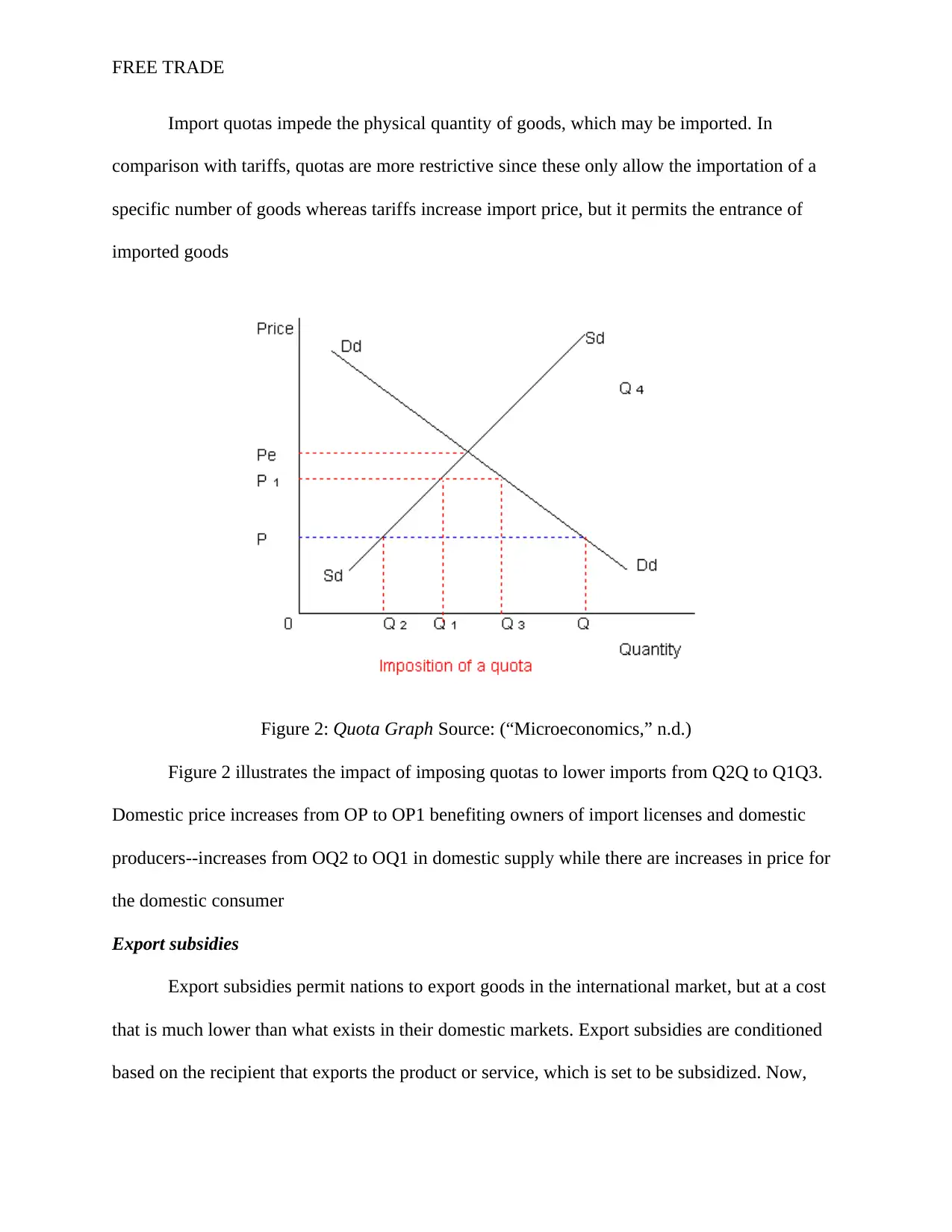
FREE TRADE
Import quotas impede the physical quantity of goods, which may be imported. In
comparison with tariffs, quotas are more restrictive since these only allow the importation of a
specific number of goods whereas tariffs increase import price, but it permits the entrance of
imported goods
Figure 2: Quota Graph Source: (“Microeconomics,” n.d.)
Figure 2 illustrates the impact of imposing quotas to lower imports from Q2Q to Q1Q3.
Domestic price increases from OP to OP1 benefiting owners of import licenses and domestic
producers--increases from OQ2 to OQ1 in domestic supply while there are increases in price for
the domestic consumer
Export subsidies
Export subsidies permit nations to export goods in the international market, but at a cost
that is much lower than what exists in their domestic markets. Export subsidies are conditioned
based on the recipient that exports the product or service, which is set to be subsidized. Now,
Import quotas impede the physical quantity of goods, which may be imported. In
comparison with tariffs, quotas are more restrictive since these only allow the importation of a
specific number of goods whereas tariffs increase import price, but it permits the entrance of
imported goods
Figure 2: Quota Graph Source: (“Microeconomics,” n.d.)
Figure 2 illustrates the impact of imposing quotas to lower imports from Q2Q to Q1Q3.
Domestic price increases from OP to OP1 benefiting owners of import licenses and domestic
producers--increases from OQ2 to OQ1 in domestic supply while there are increases in price for
the domestic consumer
Export subsidies
Export subsidies permit nations to export goods in the international market, but at a cost
that is much lower than what exists in their domestic markets. Export subsidies are conditioned
based on the recipient that exports the product or service, which is set to be subsidized. Now,
⊘ This is a preview!⊘
Do you want full access?
Subscribe today to unlock all pages.

Trusted by 1+ million students worldwide
1 out of 16
Related Documents
Your All-in-One AI-Powered Toolkit for Academic Success.
+13062052269
info@desklib.com
Available 24*7 on WhatsApp / Email
![[object Object]](/_next/static/media/star-bottom.7253800d.svg)
Unlock your academic potential
Copyright © 2020–2025 A2Z Services. All Rights Reserved. Developed and managed by ZUCOL.





